Chernivtsi, Kolomiya & Ivano Frankivsk March 19-25
The Chernobyl nuclear disaster in Ukraine shocked the world in 1986. Its inspiring Orange Revolution again captured world attention in 2004. My journey through a tiny part of western Ukraine has introduced me to this unique country with a remarkable and turbulent past.
Background
Human settlement in modern day Ukraine dates back to 32,000 BC with evidence of the Gravettian culture in the Crimean Mountains. By 4,500 BC, the Neolithic Cucuteni-Trypillian culture flourished in a wide area including the entire Dnieper-Dniester region. According to legend, three brothers, Kyi, Schek and Koriv of the Polianian tribe came to the uninhabited hills around Kiev around 560 AD. By 9th century, Kiev was a prosperous centre, midway between the Viking Realm of the Baltic and the Byzantine Empire.
By the 10th century, the Varangian (Viking) princes established Kiev as the capital of all the land between the modern day St Petersburg and Moldova and Kiev became one of the largest and most powerful cities in Europe. Vladimir the Great (980-1015) baptized his entire nation in the Dneper River in 988. His son and successor, Yaroslav the Wise (1019-1054) built Kiev’s landmark cathedral of St Sophia in 1037. Greek monks founded Kiev’s Caves Monastery which is the ecclesiastical centre of Russian Orthodoxy and the holiest place in the country.
Kiev’s fame and wealth however led to the city’s downfall in 1240 with Mongol’s invasion and annexation by the Lithuanian principality in 1362. At the beginning of the 15th century, Lithuanian granted Kiev the Magdeburg Law, a Germanic code granted to prominent cities for self-rule. Kiev prospered once again only to be destroyed by the Mongols in 1482.
Poland began ruling Kiev in 1569 leading to a large influx of Poles and Jews. The Cossacks drove the Poles out in 1648. But when the Cossacks signed an agreement with Russia in 1654, Kiev fell under Russian jurisdiction. During the Russian rule, Kiev became a central metropolis, albeit ‘Little Russia’. Following the revocation of the Magdeburg Law in 1835, Russia introduced centralized legal system.
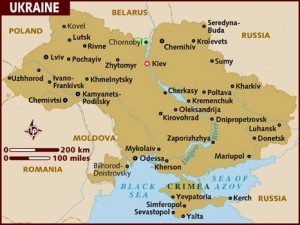 Ukraine enjoyed a short period of independence (1917-20) following the fall of the czarist Russia. But it became part of the Soviet Union till 1991. It suffered a lot during the Stalin era as a result of forced collectivization and purges of the intelligentsia and those opposing the regime. Some eight million people were believed to die during the two forced famines in 1921-22 and 1932-33. It is estimated one-sixth of the population of the Ukrainian SSR were killed during the Second World War.
Ukraine enjoyed a short period of independence (1917-20) following the fall of the czarist Russia. But it became part of the Soviet Union till 1991. It suffered a lot during the Stalin era as a result of forced collectivization and purges of the intelligentsia and those opposing the regime. Some eight million people were believed to die during the two forced famines in 1921-22 and 1932-33. It is estimated one-sixth of the population of the Ukrainian SSR were killed during the Second World War.
Ukraine today
Following the dissolution of the Soviet Union, Ukraine gained its independence in August 1991. But democracy and prosperity remained elusive as a result of the legacy of state control and endemic corruption. In 2004, Viktor Yushchenko, a reformist was elected president following a peaceful “Orange Revolution”. Nonetheless, political instability, corruption and economic and financial crises since late 1990s have hampered the country’s economic development.
Ukraine is a large country mostly made up of vast steppe and flat plateau and is renowned for its rich black soil. The Dnepr River runs south down the middle of the country. 54% of the land area of 579,330 square kilometres is arable land. The highest peak is Mt Hoveria in the Carpathian Mountains at 2061m.
Ukraine has a population of about 44.5 million. Ethnic Ukrainian and Russian comprise 78% and 17% of the population respectively. The dominant religion is Orthodox Christianity and Ukrainian Orthodoxy is mystical and meditative.
Its GDP (nominal) and PPP and GDP (per capita) PPP in 2012 were US$175 billion, 335.4 billion and $7,600 respectively. The exchange rate was about 1 Euro to 10.4 hryvnia(Hr) (March 2013). Ukraine is a popular tourist destination boasting five World Heritage Sites with six properties.
March 19 Tuesday: Suceava, Romania – Chernivtsi, Ukraine (75km)
I travelled by bus from Romania to Ukraine. The journey took less than three hours including the time spent at two border check points. The bus terminal in Chernivtsi is small and messy. No one spoke English and I could not find any money changer. Fortunately, a girl I met on the bus agreed to give me 50Hr in exchange of 5 Euro. She also found me a private taxi for 40Hr. (I later found out that the journey with a registered taxi would only cost 20Hr)
Chernivtsi is the regional capital of Bukovina. Today Romania’s northern region is still called ‘Bucovina’ and most natives regard the entire area as a single region. Chernivtsi beginning as a Galician fortress on the River Prut has been a trading centre. After Austrians gained control of the area in 1774, the city was transformed with main streets lined with exquisite and colourful buildings, including a green opera house, pink and blue townhouses and a magnificent brick residence of the Orthodox Metropolitans (the second highest-ranking officials in the Orthodox Church). During the 250 years of Habsburg rule, the city became very cosmopolitan and was ranked third in size after Vienna and Prague with an independent stock exchange and its own university. It offered a home to the rising Ukrainian intellectualism of the late 19thcentury. After the collapse of the Soviet Union, free trade returned to Chernivtsi which started the largest outdoor market in Ukraine at Kalynivksy.
I stayed at the TIU Backpackers Hostel close to the Central Square, the heart of the city. It is run by Marcus, an Englishman who has been living and running hostels in the country for seven years. I intended to spend 12 leisure days in Ukraine and Marcus suggested me visit Khotyn, Kamyanets Podilsky (Kamyanets), Kolomiya, Ivano Frankivsk, Lviv and Kiev before taking a train to Moscow. I took his advice and had a wonderful time in Ukraine.
The first place I visited was the National University of Chernivtsi founded in 1875 which is housed in the former official residence for the Orthodox Church leaders of Bukovina and Dalmatia. The complex designed by the famous Czech architect Josef Hlávka and built between 1864 and 1882 entirely with standard red bricks and brightly coloured tiles, was totally different from the classical buildings he designed in Vienna. The complex resembling a giant Lego castle with numerous of playful chimneys and miniature turrets is a World Heritage Site.
The security guard did not let me enter the main campus building. I therefore wandered around and found my way to a chapel where a service was taking place. I was attracted by the heavenly singing and chanting and stayed till the end of the service.
I had an amazing time looking at the architectures which compare well with other leading European cities. I saw a Japanese restaurant near the opera house and decided to give it a try. The sushi was fine. I enjoy the carefree atmosphere of this lively and vibrant city with lots of pubs, cafés and young students. The pedestrian street is impressive with many beautifully restored townhouses and the squares.
March 20 Wednesday: Chernivtsi
I began my day at the National University again. I paid 30Hr for a guided tour. The English speaking guide showed me the blue, marble and red rooms in the main building and the garden. The unique architectural styles look stunning against a blue and clear sky. I ended my guided tour at the chapel again.
 |
 |
 |
 |
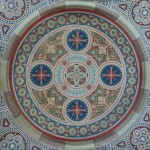 |
 |
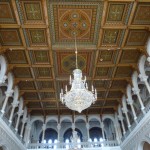 |
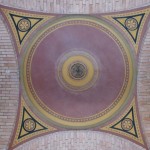 |
Marcus arranged a taxi to take me to the Kalynivksy Market for 20Hr. It is a mile-wide outdoor shopping centre which boasts some 50,000 daily visitors. I walked around to get a feel and had grilled lamb and soup for 23Hr. I took a marshrutka (minibus) to the railway station built in 1907 and walked back to the city centre.
I visited a Jewish Museum near the opera house. Chernivtsi was once home to a large and prosperous Jewish community. I also paid a visit to the Chernivtsi Regional Art Museum which I find dull with few remarkable and impressive exhibits.
There are however a few churches worth visiting. I cannot forget the shocking pink colour of the Cathedral of the Holy Spirit (1844). The red-brick Armenia Church, another Hlávka’s building in Chernivtsi was closed. When I arrived at the St Nikolai Cathedral (1930s) which has iconic twisted turrets, the place was atmospheric and packed with hundreds of people. I leaned against the wall and watched the service. I was overwhelmed and mystified by the pious Orthodox Christians, young and old who went on their knees at least 50 times during the service. They then queued up to kiss the cross.
 |
I had pasta in a cozy café run by a young couple. They asked for my opinion on the food and I am impressed by their eagerness to seek feedbacks and determination to do their best.
March 21 Thursday: Chernivtsi – Khotyn – Kamyanets Podilsky (80km)
 I took a trolley bus to the bus terminal and took the 9:30am bus to Khotyn to see the famous castle fortified by Moldavian prince Stefan III in the 15th century. After getting off at the bus station, I had to take a taxi and finally arrived at my destination at 11am. The Battle of Khotyn where the Polish forces of 35,000 quashed the Turkish advances with 250,000 troops in 1621 has brought the castle fame and immortality. The wind-swept castle by River Dnistr though not large, is picturesque with an outer wall built around natural mounds and an inner moat.
I took a trolley bus to the bus terminal and took the 9:30am bus to Khotyn to see the famous castle fortified by Moldavian prince Stefan III in the 15th century. After getting off at the bus station, I had to take a taxi and finally arrived at my destination at 11am. The Battle of Khotyn where the Polish forces of 35,000 quashed the Turkish advances with 250,000 troops in 1621 has brought the castle fame and immortality. The wind-swept castle by River Dnistr though not large, is picturesque with an outer wall built around natural mounds and an inner moat.
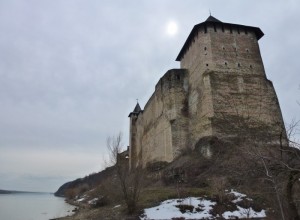 |
 |
 |
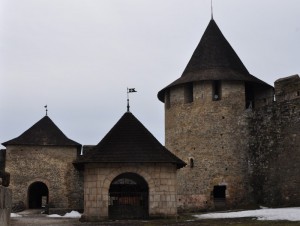 |
 |
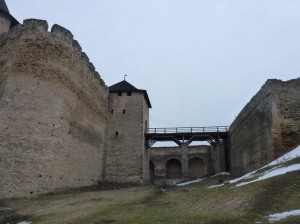 |
The sky was grey and it was freezing. The gate keeper who was having coffee with his friend invited me to join them. I was cold and appreciated a hot drink. In return I gave him oranges that I brought with me.
After spending an hour wandering inside the castle and walking around the moat, I took a while to walk back to the main road. According to Marcus, it’s easy to find bus and marshrutka to Kamyanets which is about 30km away.
Marcus was wrong. There is no timetable at the bus stop. After waiting for an hour, I was anxious and stopped a private car with a young driver and an elderly lady for assistance. The man though cannot speak English, called his friend to find out when a bus might be coming. He said there’s no fixed schedule. The lady held my hand and waited by the roadside with me for ten minutes. She managed to stop a very old car which driver was ready to take me for 20Hr. The road is very bad and bumpy. The driver drove slowly and I finally arrived at the 7-Day Hotel around 2:30pm. He is a nice man and I gave him 45Hr.
Kamyanets Podilsky has been known as a ‘museum city’ famous for its stone landscape, the spectacular setting of the old town (an island) completely encircled by an immense canyon and its diverse historic architecture. A most impressive medieval fortress is linked to the island by a causeway. The town had been a flourishing trading centre and each ethnic community with its own legal authority and religious traditions was self-ruled. The old city is a World Heritage Site because of its high concentration of preserved architectural styles.
I did not notice that the sky had darkened. I left the hotel without an umbrella. I made my way to the old city and saw the tower of the central Polish magistrate which now houses several museums. I paid 5Hr to see an underground medieval court. I would not like to be a judge there as there is no sunlight! I was hungry and tried dumplings and a dry salt fish at Bar Ratusha located at the basement of the Polish magistrate for 33Hr.
It rained heavily when I came out. I just wanted to go back to the hotel. After 20 minutes’ walk in the rain, I was wet when I got into my room. It was so miserable that I did not want to do anything. I had a swim in the heated pool in the evening. A god wholesome dinner would do me good but I could not find the restaurant recommended by Marcus. So I only had milk, bread and tin fish in my room. What a miserable day!
March 22 Friday: Kamyanets Podilsky – Chernivtsi (89km)
It snowed and rained the whole day. Despite the poor weather, I walked all the way to the old city to see the St Peter and St Paul Cathedral, a couple of churches and the fortress which is much bigger and more interesting than the Khotyn castle.
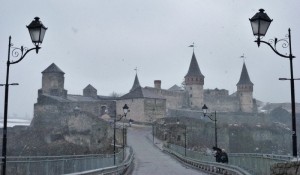 |
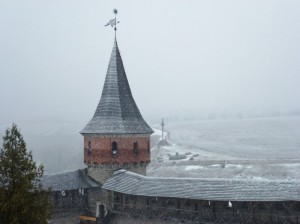 |
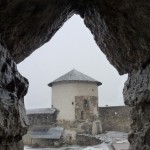 |
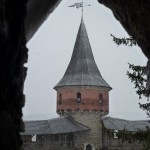 |
 |
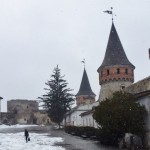 |
The old city was dead: the Polish, Russian and Armenian markets and some churches are closed. I only saw a few tourists at the fortress. Views from the towers of the fortress on a fine day must be fantastic. Anyway, the grey sky had dampened my enthusiasm for sightseeing. I just wanted to return to Chernivtsi.
I therefore took the 1:30pm bus and got back to Chernivtsi at 4pm. The countryside covered in thick snow looked pretty. I took a bus to the hostel as I could not find a taxi. Lyuba, Marcus’s wife is an excellent cook. She prepared a wonderful dinner for a young Japanese university student and me. We had bosch as starter and a hot pot with pork and potatoes as the main course. This is the best home-cooking I had in Ukraine.
Vodka is very cheap in Ukraine and Marcus said we must drink. We had a jolly evening and Marcus told us many stories. Apparently, many foreign men get to know Ukrainian girls through internet and then come to visit them for a week or two and hope to marry them one day. They would buy the girl an engagement ring and give her plenty of gifts. But often these girls would leave after taking the presents leaving the man heartbroken. Marcus said that this type of tourism accounts for some 3 billion tourism revenue for Ukraine.
March 23 Saturday: Chernivtsi – Kolomiya (80km)It was snowing when I woke up. Before leaving for the train station, I took a walk to see the oldest church in the city, St Nikolai Church (1607). This eight-sided log chapel with animal hair and hemp twine still wedged between the cracks to keep out the wind is small and most charming.
 |
 |
Marcus said he would order a taxi for me. But as he was still sleeping, I did not want to wake him up. I thought I might be able to get a taxi on the street. I was wrong. As the roads were all covered in snow, there were few taxis around. At the end, I had to walk with my suitcase and a backpack. I managed to arrive before 8:20am thinking the train would be leaving at 8:35am. But it did not leave till almost 9am.
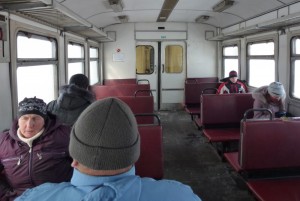 |
It was the most unforgettable train experience in my life. The train looks like those from the early 19th century without heating. It was sunny outside but the temperature inside the compartment might be -15°C. I was frozen and my feet started to defrost when I stepped out of the train in Kolomiya at 11am. I took a taxi to the Hetman Hostel recommended by Marcus. The driver did not know the way. At the end, I had to carry my suitcase walking for at least 15 minutes in the city centre which is pedestrianized. The driver charged me 25Hr for a short journey and did not help me carry my suitcase. The service was very poor indeed.
Kolomiya located in a special region of Ukraine known as Pokuttia is a pretty and elegant little town with all houses in delightful pastel colours. The Pysanky Museum is unique as it displays over 10,000 coloured Easter eggs with patterns and colours from all regions of Ukraine. Unfortunately, it was closed for renovation. I went to the Museum of Hutsul Folk Art with a good and interesting collection of Ukrainian crafts ranging from stove tiles, hand-embroidered national dress, ornate wooden axes, rugs and wooden dishes. I also saw a couple of churches.
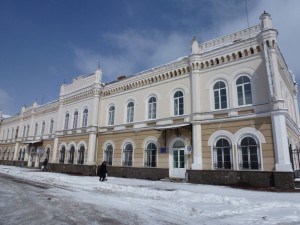 |
 |
 |
 |
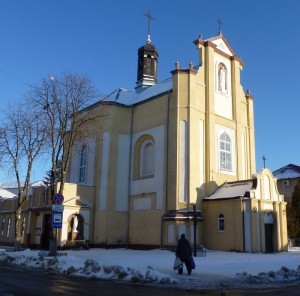 |
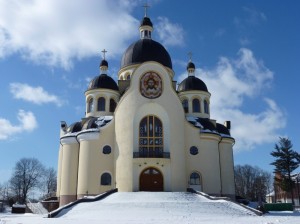 |
I had an early dinner in a local café. The chef prepared me a local meat dish which was delicious. As I was the only person staying in the hostel with four rooms, I was a bit scared. The hostel is clean, airy and bright. I felt at home and decided to spend two nights there.
March 24 Sunday: Kolomiya
I had a rest day today. The city was quiet, peaceful and picturesque. I first walked to the bus terminal to check the timetable. On the way, I stopped by two churches and watched the Sunday service.
 |
 |
 |
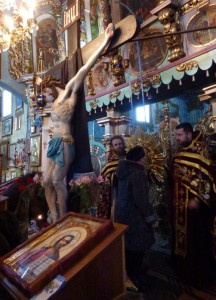 |
 |
The highlight of the day was my visit to the famous wooden Church of Annunciation (1587). It was 11am when I arrived at the church which was packed. I stayed outside till I spotted a gap near the door. The service which began at 8am did not finish till 12:15pm. The atmosphere was amazing: the people stood for four hours and some even knelt down if they could find enough space. Though I could not understand the language, I felt blessed and peaceful.
I worked on my travel notes in the afternoon and only went out for a walk at sunset. I saw a church with huge blue domes and went in. Several priests were performed the ceremony and I was again fascinated by the rituals. Though small, Kolomiya has a dozen of churches and I have visited seven major ones in two days.
March 25 Monday: Kolomiya – Ivano Frankivsk – Lviv (about 200km)
 Today I had a long day. I took the 8:15am bus to Ivano Frankivsk (Ivano), the gateway for most travel into the Carpathian Mountains. Ivano is about 60km away and the journey took less than two hours. I brought a train ticket to Lviv for 50Hr.
Today I had a long day. I took the 8:15am bus to Ivano Frankivsk (Ivano), the gateway for most travel into the Carpathian Mountains. Ivano is about 60km away and the journey took less than two hours. I brought a train ticket to Lviv for 50Hr.
Ivano bears a strong resemblance to towns in southern Poland as the city was founded by Polish aristocrats in the 17th century. It is a vibrant and prosperous city with a historic centre: the cobblestones and the grand renovated buildings are all painted in bright Easter-egg colours. There are several iconic buildings around the Polscha Rynok (Market Square), the focal point of the city. They include the Church of the Holy Resurrection (1753), the Regional Museum housed in an Art-Deco building which was the former city hall and the Regional Art Museum occupying a collegiate church (1703).
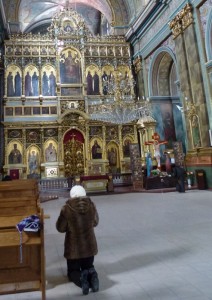 |
 |
It’s Monday and all museums were closed. I spent a couple of hours exploring two markets. The first one sells stuff for construction and car repair. The second one is the food market with hundreds of stalls both inside and outside the complex. I saw a large synagogue painted in pink and had fish for lunch in a pricy boutique hotel next to it.
 |
 |
 |
On my way to the train station, I asked a young lady for direction. She and her 19-year-old boyfriend who is studying in Lviv accompanied me to the station. He was also on his way to Lviv and helped me carry my suitcase. I took a picture of this fine couple at the railway station.
The journey was pleasant and I arrived in Lviv around 7:30pm. I planned to take a taxi but the driver asked for 50Hr. I therefore took the tram costing only 1.5Hr to the historic centre where Old City Hostel recommended by Marcus is located.








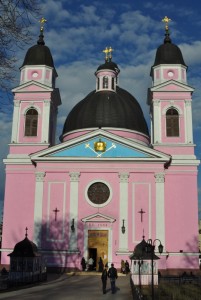












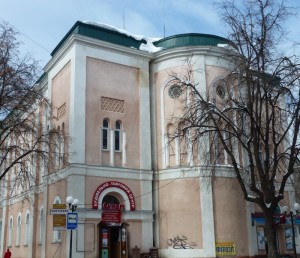
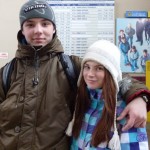
hi from Lviv